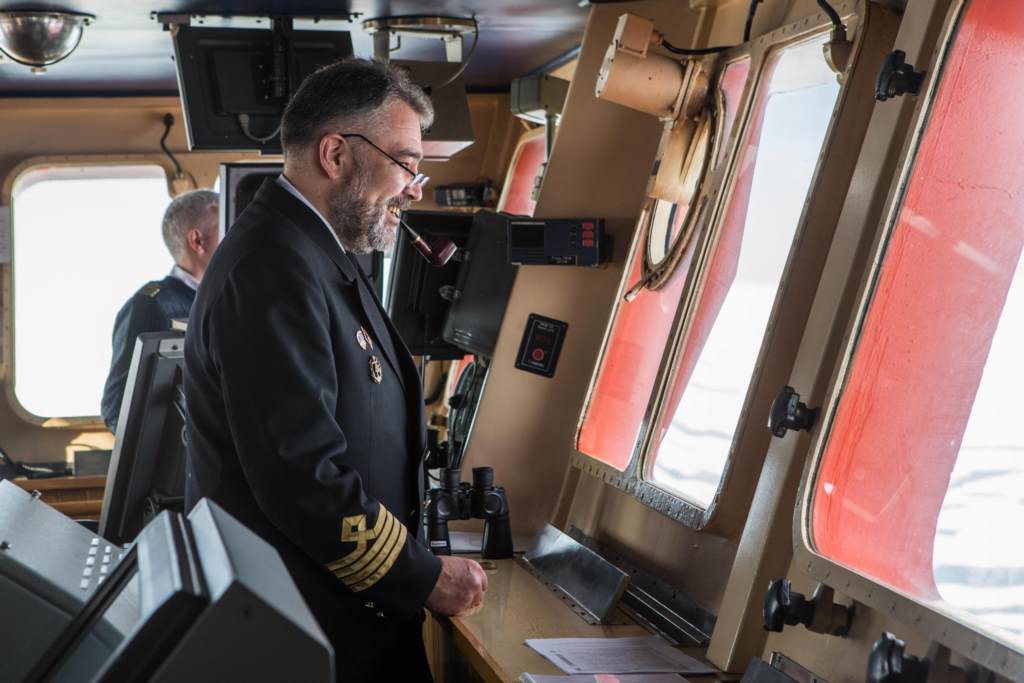During the 2019 season, ice at the North Pole was thicker and heavier than at any time over the last 15 years, according to Dmitry Lobusov, captain of the 50 Years of Victory.
During an interview for Poseidon Expeditions, the captain said “there is less and less ice in the Arctic. The ice has become thinner over the course of all my trips to the North Pole, but last year, the ice was been thicker and heavier than it was during the last 15 years.”
This poses challenges for captains, even those at the helm of icebreakers.
“During the first cruise, we just managed to meet the trip time schedule, even using all the powerful capabilities and resources of the icebreaker. We have not observed ice like that in a long time,” he added.
The 50 Years of Victory is a nuclear-powered icebreaker operated by Atomflot, part of the Rosatom Group, and generates 75,000 horsepower and can crush ice layers up to three meters thick. Poseidon Expeditions charters the ship for seasonal sailings to the North Pole.
Even though it was not purpose-built for tourists, rather to pilot scientific and cargo ships to the hard-to-reach areas of the Arctic, during the summer months the icebreaker takes passengers to the geographic North Pole.
So far, the 50 Years of Victory has taken tourists to the North Pole 51 times.
“Generally speaking, the vessel has been modernized. The fore of the ship has been improved. The newly-designed, spoon-shaped bow prevents the ship from getting stuck in the ice, unlike an icebreaker with a lean bow. Another very big plus is that the area of the ship’s hull contacting the ice has a rust-proof steel coat that significantly decreases ice friction and that, in its turn, increases the icebreaking capability,” Lobusovsays.
Captain Dmitry Lobusov has 32 years of icebreaker fleet experience, including 14 years as captain of nuclear-power icebreakers and 12 years as captain of the 50 Years of Victory.
He noted that over the course of his career in the polar travel business, he’s never met disappointed guests at the end of a voyage.
“It’s natural for people to dream of visiting those spots on the Earth where very few people have gone before them. There are only two spots like this on the Earth: the North Pole and the South Pole, where all lines of longitude converge and the Earth’s axis meets its surface. But that’s not the only reason. During and after the voyage on the icebreaker people realize they’ve gotten much more than they expected, particularly at the moment when this huge vessel smashes through heavy ice. It’s a fantastic experience to watch,” he added.
According to Lobusov, nuclear-powered icebreakers are the only truly environmental-friendly vessels in the Arctic region.
“There are no emissions, spent diesel fuel or fuel oil discharge, so there is no bilge water on nuclear icebreakers in contrast with other vessels. Any sewage water from bathrooms and the cook-galley is treated in an appropriate manner and it leaves the ship nearly clean,” he explained.
There are also several diesel-powered icebreakers exploring the central part of the Arctic at the end of August and September, when the ice is the least fast and it covers a much smaller surface area. But as Lobusov points out, these ships do not take tourists the North Pole.
“They are not passenger vessels. So until the end of August it’s kind of difficult for ships with less capability to guarantee they will reach the North Pole. On the ice, vessel capability and variable ice conditions are both factors that impact vessel speed. It’s impossible to sail faster in certain ice conditions. And you often don’t know the conditions of the ice ahead, so it’s hard to estimate schedules, especially if you’ve never been there before. So with the ice situation as it is now, it is the nuclear-powered icebreaker which gives us close to a 100 percent guarantee that it will reach the North Pole and get back on schedule,” he said.




